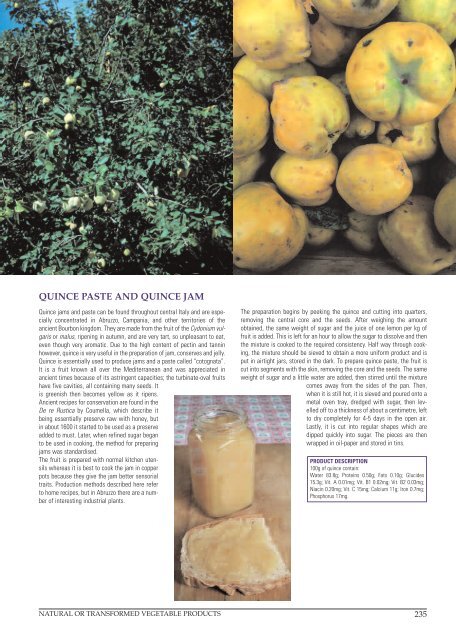9,4 Mb - formato pdf - Enoteca Regionale
9,4 Mb - formato pdf - Enoteca Regionale
9,4 Mb - formato pdf - Enoteca Regionale
Create successful ePaper yourself
Turn your PDF publications into a flip-book with our unique Google optimized e-Paper software.
QUINCE PASTE AND QUINCE JAM<br />
Quince jams and paste can be found throughout central Italy and are especially<br />
concentrated in Abruzzo, Campania, and other territories of the<br />
ancient Bourbon kingdom. They are made from the fruit of the Cydonium vulgaris<br />
or malus, ripening in autumn, and are very tart, so unpleasant to eat,<br />
even though very aromatic. Due to the high content of pectin and tannin<br />
however, quince is very useful in the preparation of jam, conserves and jelly.<br />
Quince is essentially used to produce jams and a paste called “cotognata”.<br />
It is a fruit known all over the Mediterranean and was appreciated in<br />
ancient times because of its astringent capacities; the turbinate-oval fruits<br />
have five cavities, all containing many seeds. It<br />
is greenish then becomes yellow as it ripens.<br />
Ancient recipes for conservation are found in the<br />
De re Rustica by Coumella, which describe it<br />
being essentially preserve raw with honey, but<br />
in about 1600 it started to be used as a preserve<br />
added to must. Later, when refined sugar began<br />
to be used in cooking, the method for preparing<br />
jams was standardised.<br />
The fruit is prepared with normal kitchen utensils<br />
whereas it is best to cook the jam in copper<br />
pots because they give the jam better sensorial<br />
traits. Production methods described here refer<br />
to home recipes, but in Abruzzo there are a number<br />
of interesting industrial plants.<br />
The preparation begins by peeking the quince and cutting into quarters,<br />
removing the central core and the seeds. After weighing the amount<br />
obtained, the same weight of sugar and the juice of one lemon per kg of<br />
fruit is added. This is left for an hour to allow the sugar to dissolve and then<br />
the mixture is cooked to the required consistency. Half way through cooking,<br />
the mixture should be sieved to obtain a more uniform product and is<br />
put in airtight jars, stored in the dark. To prepare quince paste, the fruit is<br />
cut into segments with the skin, removing the core and the seeds. The same<br />
weight of sugar and a little water are added, then stirred until the mixture<br />
comes away from the sides of the pan. Then,<br />
when it is still hot, it is sieved and poured onto a<br />
metal oven tray, dredged with sugar, then levelled<br />
off to a thickness of about a centimetre, left<br />
to dry completely for 4-5 days in the open air.<br />
Lastly, it is cut into regular shapes which are<br />
dipped quickly into sugar. The pieces are then<br />
wrapped in oil-paper and stored in tins.<br />
PRODUCT DESCRIPTION<br />
100g of quince contain:<br />
Water 83.8g; Proteins 0.50g; Fats 0.10g; Glucides<br />
15.3g; Vit. A 0.01mg; Vit. B1 0.02mg; Vit. B2 0.03mg;<br />
Niacin 0.20mg; Vit. C 15mg; Calcium 11g; Iron 0.7mg;<br />
Phosphorus 17mg.<br />
NATURAL OR TRANSFORMED VEGETABLE PRODUCTS 235


